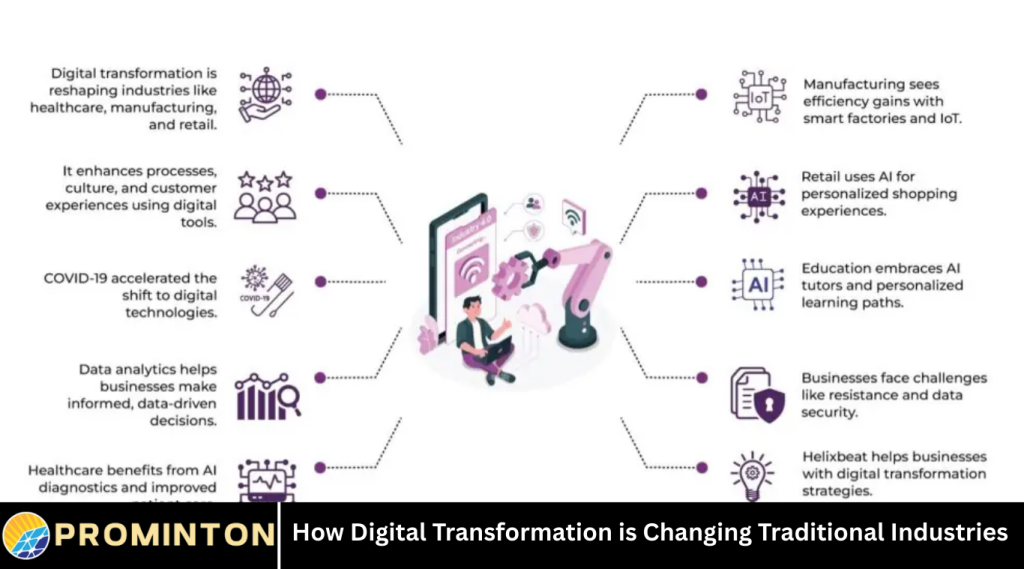Digital transformation is no longer a buzzword but a vital part of modern business strategy. Traditional industries that have operated for decades with established methods are now adapting to new digital technologies. This shift is reshaping how businesses operate, serve customers, and compete in the market.
Digital transformation involves using digital tools and technologies to improve processes, enhance customer experiences, and create new business models. For traditional industries like manufacturing, retail, finance, and healthcare, embracing digital change is crucial to stay relevant and grow.
This article explores the impact of digital transformation on traditional industries. It explains key changes, benefits, challenges, and real-world examples. Understanding these factors helps businesses prepare for a future where digital technology plays a central role.
What Is Digital Transformation?
Digital transformation means integrating digital technology into all areas of a business. It changes how companies operate internally and interact with customers and partners. It goes beyond simply using computers or software; it transforms culture, processes, and strategies.
Traditional industries often rely on manual processes, paper-based systems, and legacy equipment. Digital transformation introduces automation, data analytics, cloud computing, and connected devices to modernize these operations.
This transformation enables companies to be more agile, data-driven, and customer-focused. It opens new opportunities for innovation and growth that were not possible before.
How Digital Transformation Affects Traditional Industries
Improved Operational Efficiency
One major impact is better efficiency. Digital tools automate repetitive tasks and streamline workflows. For example, manufacturing plants use sensors and robotics to monitor production and reduce errors. This leads to faster output and lower costs.
In retail, inventory management systems track stock in real-time, preventing overstocking or shortages. Finance companies use software to process transactions quickly and securely. Across industries, automation frees employees from mundane tasks so they can focus on higher-value work.
Enhanced Customer Experience
Digital transformation helps traditional industries offer personalized and seamless customer experiences. Companies collect data to understand customer preferences and behaviors. This allows tailored services and targeted marketing.
Retailers provide online shopping with easy payment options and fast delivery. Banks offer mobile apps for account management and instant support. Healthcare providers use telemedicine to connect patients with doctors remotely.
Improving customer experience builds loyalty and attracts new clients, essential for business success.
New Business Models and Revenue Streams
Digital technologies enable traditional industries to innovate business models. For example, manufacturers offer “product as a service” models where customers pay for usage rather than ownership. This shifts the focus from selling goods to delivering value over time.
Retailers adopt e-commerce platforms alongside physical stores, reaching a wider audience. Financial institutions develop fintech solutions like peer-to-peer lending and digital wallets. Healthcare uses data analytics to offer preventive care and personalized treatments.
These new models create fresh revenue sources and competitive advantages.
Data-Driven Decision Making
Digital transformation provides access to large amounts of data. Companies analyze this data to make informed decisions about products, operations, and customers.
For example, manufacturers use data from sensors to predict machine failures before they happen. Retailers analyze buying patterns to stock popular items and plan promotions. Banks assess credit risks using customer data and machine learning.
Data-driven decisions reduce risks, optimize resources, and improve outcomes.
Challenges in Digital Transformation for Traditional Industries
While digital transformation offers many benefits, it also presents challenges. Traditional industries may face resistance to change from employees used to established ways. Implementing new technology requires investment and training.
Legacy systems might be incompatible with modern digital solutions. Ensuring data security and privacy is critical as cyber threats increase. Additionally, small businesses may struggle to keep up with rapid technological advances due to limited resources.
Successful transformation requires strong leadership, clear strategy, and ongoing support to overcome these obstacles.
Real-World Examples of Digital Transformation
Several traditional industries demonstrate how digital transformation works in practice:
- Manufacturing: Factories use the Internet of Things (IoT) to connect machines and monitor production remotely. This improves efficiency and reduces downtime.
- Retail: Many stores have integrated online shopping platforms with physical outlets, creating a seamless omnichannel experience.
- Finance: Banks use artificial intelligence to detect fraud and provide customer support through chatbots.
- Healthcare: Hospitals adopt electronic health records and telehealth services to enhance patient care.
Preparing for Digital Transformation
Traditional industries must prepare carefully for digital change. This includes assessing current technology and processes to identify areas for improvement. Investing in employee training ensures staff can use new tools effectively.
Partnering with technology providers or consultants helps implement solutions smoothly. Setting measurable goals and monitoring progress keeps transformation efforts on track. Importantly, companies should foster a culture that embraces innovation and continuous learning.
Frequently Asked Questions
What does digital transformation mean for traditional industries?
Digital transformation means using digital technology to change how traditional industries operate, improve efficiency, and serve customers better.
How can traditional industries improve customer experience through digital transformation?
By using data and digital tools, businesses can personalize services, offer online options, and provide faster support to customers.
What are some common challenges faced during digital transformation?
Challenges include employee resistance, costs of new technology, legacy system issues, and ensuring data security.
How does data-driven decision making benefit businesses?
It helps companies make informed choices, reduce risks, optimize resources, and improve overall performance.
Can small traditional businesses successfully undergo digital transformation?
Yes, with the right strategy, training, and partnerships, even small businesses can adopt digital technologies effectively.
What role does leadership play in digital transformation?
Strong leadership is crucial to guide change, set vision, allocate resources, and motivate employees to embrace new ways.
How does digital transformation create new business models?
It enables businesses to offer innovative services like subscriptions, online sales, and data-driven personalized products.
Conclusion
Digital transformation is reshaping traditional industries by improving efficiency, enhancing customer experiences, enabling new business models, and supporting data-driven decisions. Although challenges exist, embracing digital technologies is essential for long-term success.
Traditional businesses that adapt to the digital age can compete better, reduce costs, and offer greater value to customers. Preparing thoughtfully and fostering a culture of innovation will help industries thrive in an increasingly digital world.



